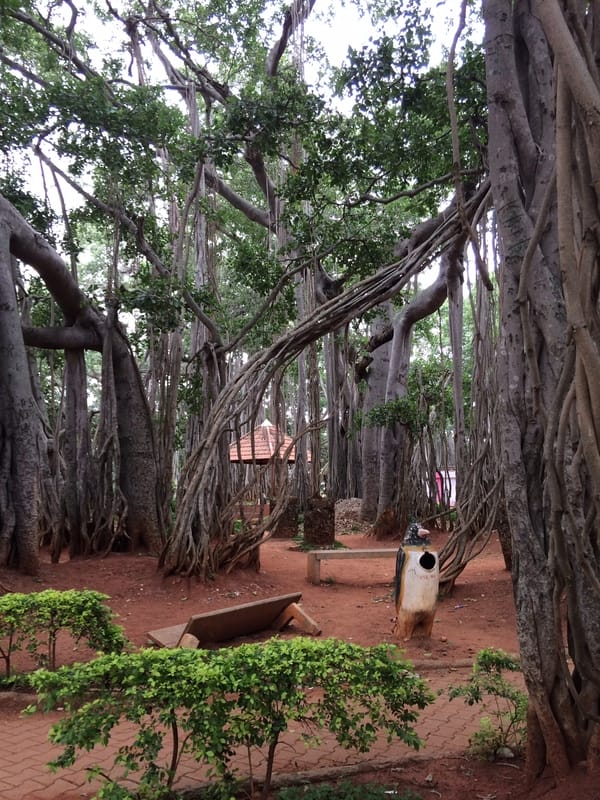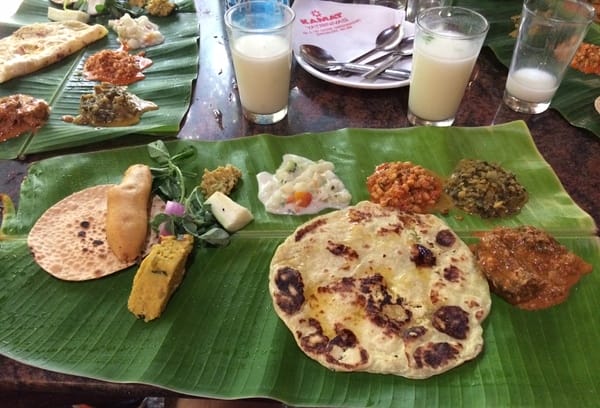A distant view of Biligudda (white hill) across a river. Behind white hill is Karigudda (black hill). Pic:Christopher Martin Lopaze
The day after my one-day guided bike tour to rural Bengaluru, my forearms were slightly sunburned, my palms were tender—my fingers were spared fortunately—and my legs and behind were sore; temporary souvenirs I’ve now lost. But the experience is one I shall not forget. I booked a guided bike tour because I wanted to leave the city behind, and see the countryside.
Only one other rider, Ray, was on the tour. The total trip distance was about 35 km. A tour guide and a driver of the support car rounded off our small group. We met at UB City Mall at 7.30 am, and were driven for about an hour to our rendezvous at The Country Club where we started our trip proper.
Beginning of the trek
The weather was cloudy in the morning, keeping the temperature cool. The heavy rain clouds never followed through with their threat to rain. In the afternoon, the cloud cover receded, and the temperature grew warmer.
I crashed once, only a minor spill — I managed to stay on my feet. I did have one scary experience when I was going down a steep hill. Halfway down I realized I needed to slow down so I applied pressure to the brakes. The back wheel was lifted off the ground, and my centre of balance was thrown forward. My feet were shoved off of the rapidly spinning pedals. Somehow I regained my footing on the pedals to recover my balance. Accident barely averted.
The first stretch of the trip ended at a planned stop at the Big Banyan Tree. It’s massive. I could not find an adequate vantage point to snap a decent picture that would accurately show its size. Sadly, the mother trunk had died from a disease a couple years ago. This particular tree is 400-year-old, and spans three acres. And it’s only the fourth largest Banyan tree in the world. The other three are in Calcutta, Mumbai, and Delhi.
A few of the intertwined branches of the Big Banyan Tree, the fourth largest Banyan tree in the world. Pic:Christopher Martin Lopaze
Unexpected sights and other delights
Even though there were some intentional sightseeing locations on the route like the Big Banyan Tree, the spontaneous stops proved to be the best part of the trip.
I passed through many villages. They all started to look the same after awhile. I was surprised to find that these villages were not completely cut off from the modern world; it was jolting to see Pepsi and Coke products being sold at local stores. I saw many agricultural fields, some empty since their yield was out of season, others laden with crops.
On our ride, we picked fruit from trees growing near the road. We tried tamarind, a fruit with a sticky and chewy texture. If you eat too much it causes tooth sensitivity. We also tried sour gooseberries.
This will sound weird, but I brushed my teeth with the branch of a tree — neem tree. This particular tree branch had antibacterial properties. Our tour guide claimed used to regularly use this type of tree branch to clean his teeth when he was growing up.
A stop in the silkland
We stopped at a random house to watch two men construct a bamboo bed to house the cocoons of silkworms. The men each sat on one side of the bamboo bed. They tied a coconut rope onto the head of a large needle, and passed the needle back and forth to secure bamboo coils onto the bed in widening oval shapes. It looked like a maze.
In the next village, we saw the fully constructed bamboo beds with the white, fuzzy cocoons already attached to the bed. If you shake the cocoon, you can hear the hollow sound of the silkworm knocking against the walls like candy in a plastic eggshell during Easter. A group of women pulled the delicate strands of silk from the fully matured cocoons, and collected them in a basket.
Eventually the silk would be transported to the city, and turned into a product to be sold at a market. I usually do not consider the individual steps in the chain necessary to produce a good. When I eat a sandwich, I do not think of the farmer that grew the grain, or the driver that transported the bread to the city, or the baker that toiled in front of the oven.
Still maturing silkworm cocoons nestled within bamboo coils. Pic:Christopher Martin Lopaze
Celebrity for a day!
Perhaps the oddest thing about the trip was how excited school children would become at our appearance. They would yell hello, smile wide, and wave enthusiastically. I’ve read about how in some parts of India, locals take pictures with foreigners because seeing a foreigner is so rare.
I confess, with some embarrassment, that I enjoyed being greeted in such a manner. It was as if I was a movie star at a premiere, waving to his adoring fans.
The first group of school children we rode past were waiting for a bus. They started to cheer and reach out their hands for a high five. I foolishly attempted to high five one of them, thereby losing my balance. My bike veered dangerously close to the children, almost hitting them. From then on, I made the conservative choice to smile and say hello. I sometimes dared to remove my hand from the handlebar to wave.
Lunch time, just in time..
By the end of our ride, I was nearing the limits of my reserves of energy. I could not have gone much further. My legs were sore and tired when we stopped for lunch about 1.30 pm. It was convenient timing for another reason; hunger was gnawing at my empty stomach.
We ate lunch at Kamat, a restaurant that serves Kannadiga style cuisine. This has been the best meal I’ve eaten in India so far. Instead of serving food on a plate, they use a giant leaf, which I was told was banana. The four of us ordered the special meal. It was essentially a buffet, except we did not have to leave our seats to restock our “plates;” the wait staff regularly stopped by the table, and if there was a lack of any particular item, they replaced it.
All of us greedily consumed the meal as we had worked up quite an appetite. It was a gruesome spectacle. There was sweet chapati (which is called obbattu here) with ghee, and rice. There was corn roti and rice roti; I preferred the corn variety. We had various sauces to dip our food in. Three of the sauces were spicy. One was a white sauce with onions and tomatoes that provided a welcome relief to my burning palate.
A “plate” full of food for lunch at Kamat restaurant. Pic:Christopher Martin Lopaze
The art of toy-making
Our last stop was a toy factory in Channapatna, a town famous for its manufacture of wooden toys constructed from the Aalemara tree, commonly known as ivory wood. The craft originated in Persia, but has been practiced in India for about 400 years.
The wood is left out in the open air for two to six months to season; formerly composed of 80 percent water, after the seasoning process it’s only 8% water, making it nearly weightless. Once the wood is finished drying, it’s left in an oven for two or three days and smoked.
Workers set the wood on a machine, operated by a pulley belt, that rapidly spins the wood. The workers use tools to carve the wood into different shapes as it spins. Underneath the workstations, there were wood shavings in piles about 10 to 12 inches high. They don’t go to waste; instead, they are collected to be ground into a fine powder, and used as incense.
The final step is colouring the toys using a paint stick created by mixing lac (insect secretion) with a different combination of three vegetables dyes: kumkuma, turmeric powder, and indigo. Different combinations of the dyes produce nine colours. The stick is pressed against the plain wood as it rotates, and the colour spreads quickly across the entire surface of the wood.
All good things come to an end
After the Channapatna tour was over, we were driven back to Bangalore. The discordant choir of car horns greeted our arrival, and once again we became connected to the relentless pulse of city life.




Lac is NOT AN INSECT SECRETION. It is a plant secretion from the trunk of a tree like gum.MSR
Well written and articulate! The white sauce is nothing but salad with curd (yogurt) ,minced onions, tomato and cucumber with a dash of green chillies.